Detrital Zircon U-Pb Age Data and Geochemistry of Clastic Rocks in the Xiahe–Hezuo Area: Implications for the Late Paleozoic–Mesozoic Tectonic Evolution of the West Qinling Orogen
Abstract
1. Introduction
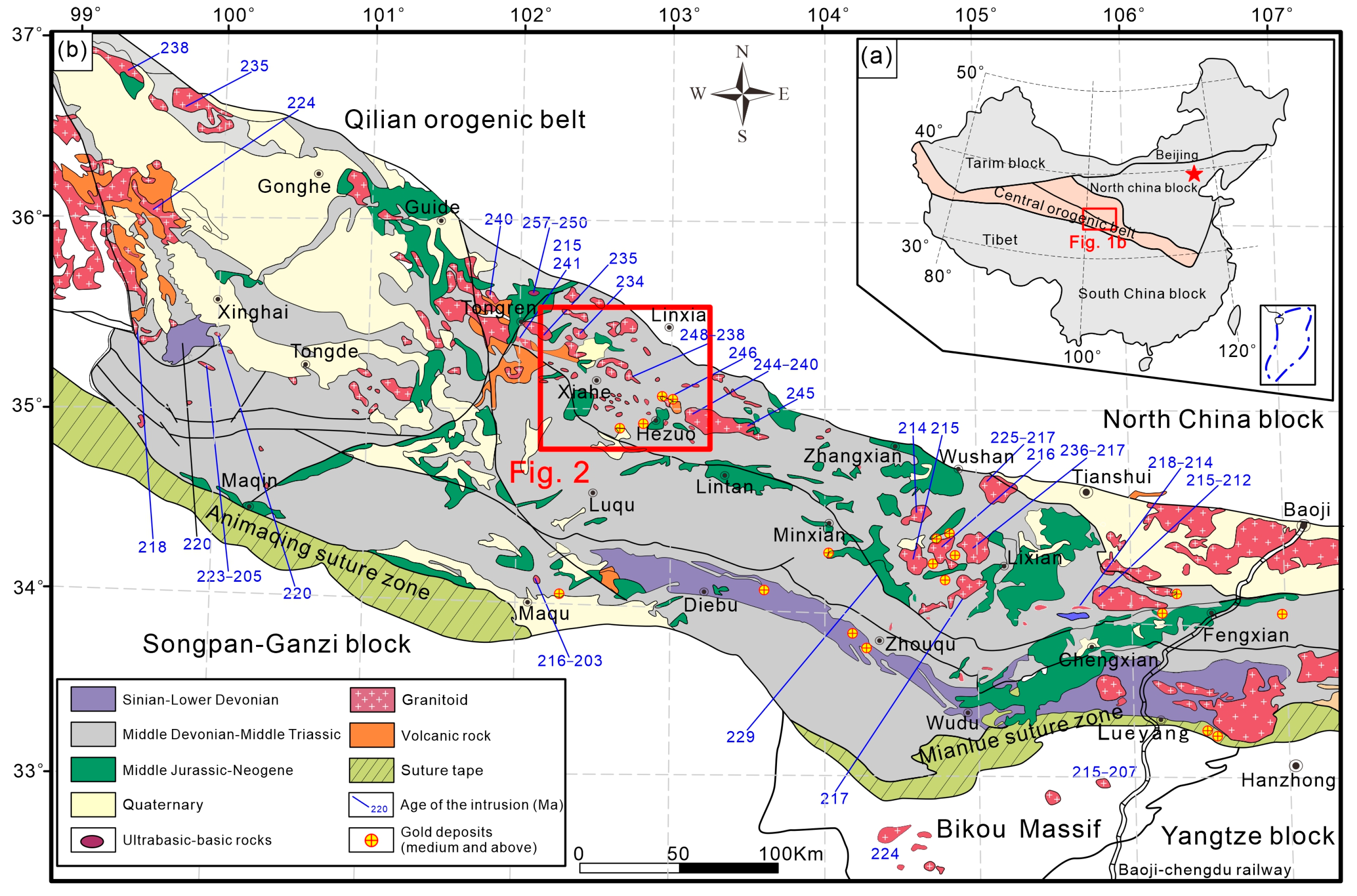
2. Geological Background
3. Sample Selection and Analytical Methods
3.1. Sample Selection
3.2. Methods
3.2.1. Zircon U-Pb Dating
3.2.2. Whole-Rock Major and Trace Element Analysis
4. Results
4.1. Detrital Zircon U-Pb Age Data
4.2. Clastic Rock Petrographic Features
4.3. Whole-Rock Geochemical Data
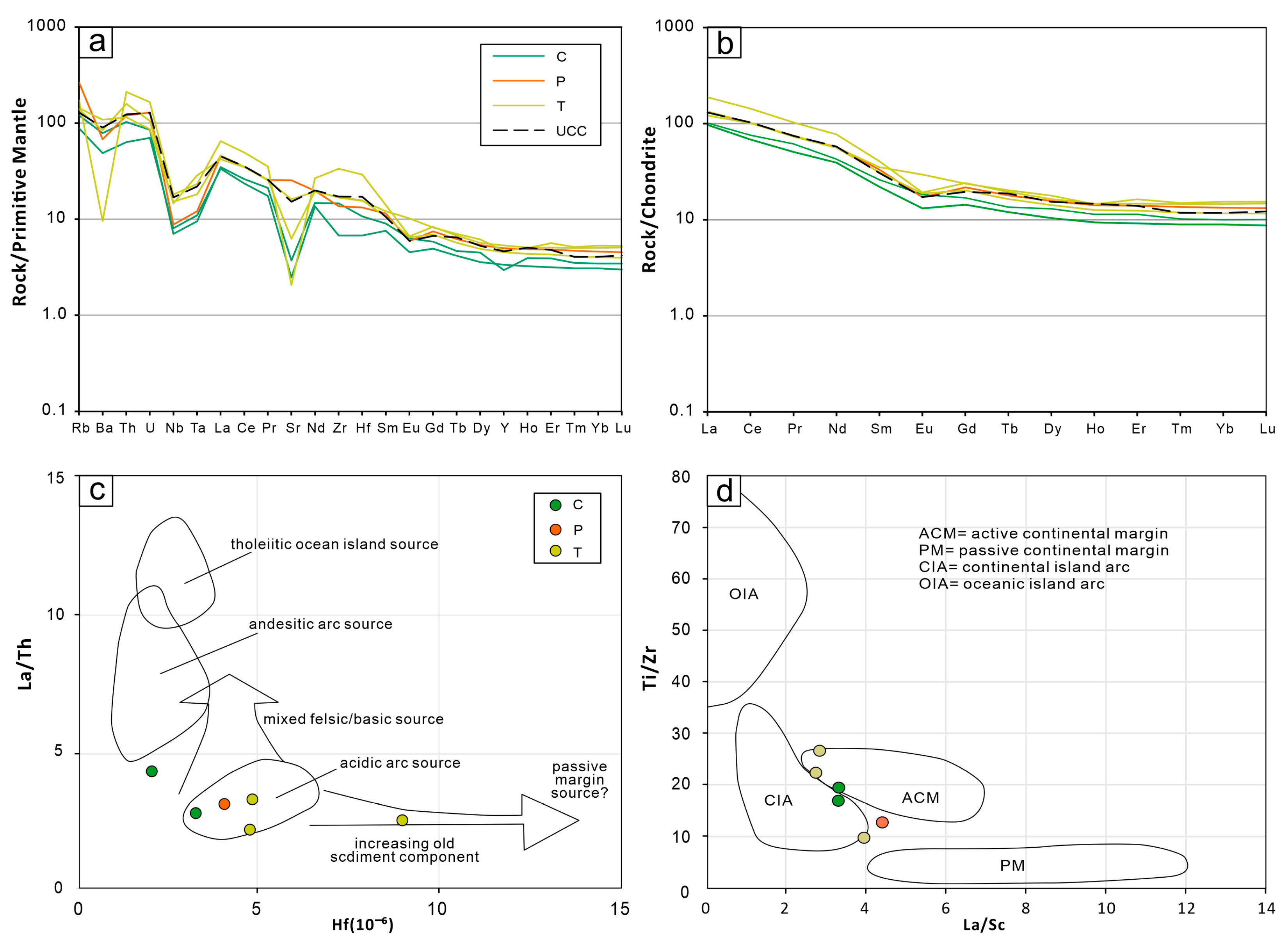
5. Discussion
5.1. Provenance of Detrital Zircon Grains
5.2. Sedimentary Environment and Tectonic Background
5.3. Tectonic Evolution of the WQMB from Late Paleozoic to Mesozoic
6. Conclusions
- (1)
- The Devonian–Carboniferous strata in the WQOB are dominated by Neoproterozoic (~800–900 Ma) zircon populations, whereas the Permian–Triassic strata exhibit prominent Paleoproterozoic (1840–1880 Ma) and Archean (2450–2500 Ma) age peaks.
- (2)
- The clastic rocks from the Devonian to Triassic periods in the WQOB show geochemical signatures that are comparable to the composition of the upper continental crust. This suggests that they formed in a continental island arc and active continental margin setting.
- (3)
- By integrating our findings with existing datasets from studies of detrital zircon age dating, volcanic and plutonic activity, ancient rock layer sequences, and geophysical investigations, we propose that the WQOB underwent a tectonic evolution during the Triassic characterized by pre-Triassic subduction and localized extension during the subduction process.
Supplementary Materials
Author Contributions
Funding
Data Availability Statement
Conflicts of Interest
References
- Enkin, R.J.; Yang, Z.; Chen, Y.; Courtillot, V. Paleomagnetic constraints on the geodynamic history of the major blocks of China from the Permian to the present. J. Geophys. Res. 1992, 97, 13953. [Google Scholar] [CrossRef]
- Kröner, A.; Zhang, G.W.; Sun, Y. Granulites in the Tongbai Area, Qinling Belt, China: Geochemistry, petrology, single zircon geochronology, and implications for the tectonic evolution of eastern Asia. Tectonics 1993, 12, 245–255. [Google Scholar] [CrossRef]
- Okay, A.I.; Sßengör, A.M.C.; Satir, M. Tectonics of an ultrahigh-pressure metamorphic terrane: The Dabie Shan/Tongbai Shan Orogen, China. Tectonics 1993, 12, 1320–1334. [Google Scholar] [CrossRef]
- Hacker, B.R.; Ratschbacher, L.; Webb, L.; Ireland, T.; Walker, D.; Shuwen, D. U/Pb zircon ages constrain the architecture of the ultrahigh-pressure Qinling-Dabie Orogen, China. Earth Planet. Sci. Lett. 1998, 161, 215–230. [Google Scholar] [CrossRef]
- Hu, F.Y.; Liu, S.W.; Santosh, M.; Deng, Z.B.; Wang, W.; Zhang, W.Y.; Yan, M. Chronology and tectonic implications of Neoproterozoic blocks in the South Qinling Orogenic Belt, Central China. Gondwana Res. 2016, 30, 24–47. [Google Scholar] [CrossRef]
- Qiu, K.F.; Taylor, R.D.; Song, Y.H.; Yu, H.C.; Song, K.R.; Li, N. Geologic and geochemical insights into the formation of the Taiyangshan porphyry copper-molybdenum deposit, Western Qinling Orogenic Belt, China. Gondwana Res. 2016, 35, 40–58. [Google Scholar] [CrossRef]
- Qiu, K.F.; Yu, H.C.; Gou, Z.Y.; Liang, Z.L.; Zhang, J.L.; Zhu, R. Nature and origin of Triassic igneous activity in the Western Qinling orogen: The Wenquan composite pluton example. Int. Geol. Rev. 2018, 60, 242–266. [Google Scholar] [CrossRef]
- Yu, H.C.; Qiu, K.F.; Pirajno, F.; Zhang, P.; Dong, W. Revisiting phanerozoic evolution of the Qinling orogen (East Tethys) with perspectives of detrital zircon. Gondwana Res. 2021, 103, 426–444. [Google Scholar] [CrossRef]
- Roger, F.; Malavieille, J.; Leloup, P.H.; Calassou, S.; Xu, Z. Timing of granite emplacement and cooling in the Songpan-Ganzi Fold Belt (eastern Tibetan Plateau) with tectonic implications. J. Asian Earth Sci. 2004, 22, 465–481. [Google Scholar] [CrossRef]
- Enkelmann, E.; Weislogel, A.; Ratschbacher, L.; Eide, E.; Renno, A.; Wooden, J. How was the Triassic Songpan-Ganzi basin filled? A provenance study. Tectonics 2007, 26, TC4007. [Google Scholar] [CrossRef]
- Weislogel, A.L. Tectonostratigraphic and geochronologic constraints on evolution of the northeast Paleotethys from the Songpan-Ganzi complex, central China. Tectonophysics 2008, 451, 331–345. [Google Scholar] [CrossRef]
- Xiao, C.H.; Chen, Z.L.; Han, F.B.; Wei, L.X.; Ma, L.T. Provenance and tectonic significance of lower Triassic clastic sedimentary rocks of the West Qinling Orogenic Belt, Central China. J. Asian Earth Sci. 2022, 224, 105026. [Google Scholar] [CrossRef]
- Li, H.L.; Gao, R.; Huang, X.F.; Wang, H.Y.; Guo, X.Y.; Liang, H.D.; Tan, X.M.; Liu, X.H.; Yang, Z. Triassic convergence and tectonic evolution of the West Qinling orogen: Constraints from reflection-seismology imaging. Gondw. Res. 2023, 122, 1–10. [Google Scholar] [CrossRef]
- Yin, A.; Nie, S. An indentation model for the North and South China collision and the development of the Tan-Lu and Honam Fault Systems, eastern Asia. Tectonics 1993, 12, 801–813. [Google Scholar] [CrossRef]
- Nie, S.Y.; Yin, A.; Rowley, D.B.; Jin, Y.G. Exhumation of the Dabie Shan ultrahigh-pressure rocks and accumulation of the Songpan-Ganzi flysch sequence, central China. Geology 1994, 22, 999–1002. [Google Scholar] [CrossRef]
- Zhou, D.; Graham, S.A. The Songpan-Ganzi complex of the West Qinling Shan as a Triassic remnant ocean basin. In Tectonic Evolution of Asia; Yin, A., Harrison, T.M., Eds.; Cambridge University Press: Cambridge, UK, 1996; pp. 281–299. [Google Scholar]
- Celâlşengör, A.M. Tectonics of the Tethysides: Orogenic Collage Development in a Collisional Setting. Annu. Rev. Earth Planet. Sci. 2003, 15, 213. [Google Scholar] [CrossRef]
- Yang, Z.R. The formation and evolution of the Songpan-Ganze fore-arc basin, western Sichuan. Sediment. Geol. Tethyan Geol. 2002, 22, 53–59, (In Chinese with English Abstract). [Google Scholar]
- Meng, Q.R.; Wang, E.; Hu, J.M. Mesozoic sedimentary evolution of the Northwest Sichuan basin: Implication for continued clockwise rotation of the South China block. Geol. Soc. Am. Bull. 2005, 117, 396–410. [Google Scholar] [CrossRef]
- Xia, L.; Yan, Q.R.; Xiang, J.Z.; Jiang, W.; Song, B.; Chen, H.M. Late Triassic andesitic accretionary arc in the central Songpan-Ganzi terrane and its tectonic significance. Acta Petrol. Sin. 2017, 33, 579–604, (In Chinese with English Abstract). [Google Scholar]
- Yang, W.T.; Wang, M.; Zheng, D.S.; Du, Y.S. Late Triassic sedimentary record from the Nanzhao Basin and implications for the orogeny in the Qinling Orogenic Belt, central China. J. Asian Earth Sci. 2018, 166, 120–135. [Google Scholar] [CrossRef]
- Burchfiel, B.C.; Chen, Z.L.; Liu, Y.P.; Royden, L.H. Tectonics of the Longmen Shan and adjacent regions, central China. Int. Geol. Rev. 1995, 37, 661–735. [Google Scholar] [CrossRef]
- Hsü, K.J.; Pan, G.; Sengör, A.M.C.; Briegel, U.; Chen, H.; Chen, C.; Harris, N.; Hsu, P.; Li, J.; Lee, T.; Li, Z.X.; et al. Tectonic evolution of the Tibetan Plateau: A working hypothesis based on the archipelago model of orogenesis. Int. Geol. Rev. 1995, 37, 473–508. [CrossRef]
- Pullen, A.; Kapp, P.; Gehrels, G.E.; Vervoort, J.D.; Ding, L. Triassic continental subduction in central Tibet and Mediterranean-style closure of the Paleo-Tethys Ocean. Geology 2008, 36, 351–354. [Google Scholar] [CrossRef]
- Ding, L.; Yang, D.; Cai, F.L.; Pullen, A.; Kapp, P.; Geherls, G.E.; Zhang, L.Y.; Zhang, Q.F.; Lai, Q.Z.; Yue, Y.H.; et al. Provenance analysis of the Mesozoic Hoh-Xil-Songpan-Ganzi turbidites in northern Tibet: Implications for the tectonic evolution of the eastern Paleo-Tethys Ocean. Tectonics 2013, 32, 34–48. [Google Scholar] [CrossRef]
- Li, L.; Meng, Q.R.; Pullen, A.; Garzione, C.N.; Wu, G.L.; Wang, Y.L.; Ma, S.X.; Duan, L. Late Permian-early Middle Triassic back-arc basin development in West Qinling, China. J. Asian Earth Sci. 2014, 87, 116–129. [Google Scholar] [CrossRef]
- Li, J.W.; Sui, J.X.; Jin, X.Y.; Wen, G.; Chang, J.; Zhu, R.; Zhan, H.Y.; Wu, W.H. The intrusion-related gold deposits in the Xiahe Hezuo district, West Qinling Orogen: Geodynamie setting and exploration potential. Earth Sci. Front. 2019, 26, 17–32, (In Chinese with English Abstract). [Google Scholar]
- Yang, L.Q.; Deng, J.; Dilek, Y.; Qiu, K.F.; Ji, X.Z.; Li, N.; Taylor, R.D.; Yu, J.Y. Structure, geochronology, and petrogenesis of the Late Triassic Puziba granitoid dikes in the Mianlue suture zone, Qinling orogen, China. Geol. Soc. Am. Bull. 2015, 11, 1831–1854. [Google Scholar] [CrossRef]
- Li, H.; Wang, C.; Willis, H.; Hao, J.B.; Joseph, G.M.; Yu, Z.P.; Zhang, S.; Sun, X.K.; Ma, D.Q.; Li, X. Grenville age basement and early Paleozoic reworking in the Qilian Orogen, NW China: Implications for paleotectonic reconstruction of Rodinia and Gondwana. J. Asian Earth Sci. 2022, 237, 105351. [Google Scholar] [CrossRef]
- Duan, M.; Niu, Y.L.; Kong, J.J.; Sun, P.; Hu, Y.; Zhang, Y.; Chen, S.; Li, J.Y. Zircon U-Pb geochronology, Sr-Nd-Hf isotopic composition and geological significance of the Late-Triassic Baijiazhuang and Lvjing granitic plutons in West Qinling orogen. Lithos 2016, 260, 443–456. [Google Scholar] [CrossRef]
- Dong, Y.P.; Yang, Z.; Liu, X.M.; Sun, S.S.; Li, W.; Cheng, B.; Zhang, F.F.; Zhang, X.N.; He, D.F.; Zhang, G.W. Mesozoic intracontinental orogeny in the Qinling Mountains, central China. Gondwana Res. 2016, 30, 144–158. [Google Scholar] [CrossRef]
- Dong, Y.P.; Zhang, G.W.; Neubauer, F.; Liu, X.M.; Genser, J.; Hauzenberger, C. Tectonic evolution of the Qinling orogen, China: Review and synthesis. J. Asian Earth Sci. 2011, 41, 213–237. [Google Scholar] [CrossRef]
- Qiu, K.F.; Deng, J. Petrogenesis of granitoids in the Dewulu skarn copper deposit: Implications for the evolution of the Paleotethys ocean and mineralization in western Qinling, China. Ore Geol. Rev. 2017, 90, 1078–1098. [Google Scholar] [CrossRef]
- Feng, Y.M.; Cao, X.D.; Zhang, E.P.; Hu, Y.X.; Pan, X.P.; Yang, J.L.; Jia, Q.Z.; Li, W.M. Tectonic evolution framework and nature of the west Qinling orogen belt. Northwestern Geol. 2003, 2003, 1–10, (In Chinese with English Abstract). [Google Scholar]
- Dong, Y.P.; Santosh, M. Tectonic architecture and multiple orogeny of the Qinling Orogenic Belt, Central China. Gondwana Res. 2016, 29, 1–40. [Google Scholar] [CrossRef]
- Dong, Y.; Sun, S.; Santosh, M.; Zhao, J.; Sun, J.; He, D.; Shi, X.; Hui, B.; Cheng, C.; Zhang, G. Central China Orogenic Belt and amalgamation of East Asian continents. Gondwana Res. 2021, 100, 131–194. [Google Scholar] [CrossRef]
- Li, X.W.; Mo, X.X.; Yu, X.H.; Ding, Y.; Huang, X.F.; Wei Pand He, W.Y. Petrology and geochemistry of the Early Mesozoic pyroxene andesites in the Maixiu area, West Qinling, China: Products of subduction or syn-collison? Lithos 2013, 172–173, 158–174. [Google Scholar] [CrossRef]
- Feng, Y.M.; Cao, X.Z.; Zhang, E.P. Structure, Orogenic Processes and Geodynamic of the Western Qinling Orogen; Xi’an Map Press: Xi’an, China, 2002; (In Chinese with English Abstract). [Google Scholar]
- Liu, H.J.; Chen, Y.J.; Mao, S.D.; Zhao, C.H.; Yang, R.S. Element and Sr-Nb-Pb isotope geochemistry of ganite-porphyry dykes in the Yangshan gold belt, western Qinling orogen. Acta Petrol. Sin. 2008, 24, 1101–1111, (In Chinese with English Abstract). [Google Scholar]
- Luo, B.; Zhang, H.; Xu, W.; Yang, H.; Zhao, J.; Guo, L.; Zhang, L.; Tao, L.; Pan, F.; Gao, Z. The Magmatic Plumbing System for Mesozoic High-Mg Andesites, Garnet-bearing Dacites and Porphyries, Rhyolites and Leucogranites from West Qinling, Central China. J. Petrol. 2018, 59, 447–482. [Google Scholar] [CrossRef]
- Jin, W.J.; Zhang, Q.; He, D.F.; Jia, X.Q. SHRIMP dating of adakites in western Qinling and their implications. Acta Petrol. Sin. 2005, 3, 950–966, (In Chinese with English Abstract). [Google Scholar]
- Luo, B.J.; Zhang, H.F.; Xu, W.C.; Guo, L.; Pan, F.B.; Yang, H. The Middle Triassic Meiwu Batholith, West Qinling, Central China: Implications for the evolution of compositional diversity in a composite Batholith. J. Petrol. 2015, 56, 1139–1172. [Google Scholar] [CrossRef]
- Li, X.W.; Mo, X.X.; Bader, T.; Scheltens, M.; Yu, X.H.; Dong, G.C.; Huang, X.F. Petrology, geochemistry and geochronology of the magmatic suite from the Jianzha Complex, central China: Petrogenesis and geodynamic implications. J. Asian Earth Sci. 2014, 95, 164–181. [Google Scholar] [CrossRef]
- Zhang, H.F.; Jin, L.L.; Zhang, L.; Harris, N.; Zhou, L.; Hu, S.H.; Zhang, B.R. Geochemical and Pb-Sr-Nd isotopic compositions of granitoids from western Qinling belt: Constraints on basement nature and tectonic affinity. Sci. China Ser. D-Earth Sci. 2007, 50, 184–196, (In Chinese with English Abstract). [Google Scholar] [CrossRef]
- Qin, J.F.; Lai, S.C.; Grapes, R.; Diwu, C.R.; Ju, Y.J.; Li, Y.F. Geochemical evidence for origin of magma mixing for the Triassic monzonitic granite and its enclaves at Mishuling in the Qinling orogen (central China). Lithos 2009, 112, 259–276. [Google Scholar] [CrossRef]
- Cao, X.F.; Lv, X.B.; Yao, S.Z.; Mei, W.; Zou, X.Y.; Chen, C.; Liu, S.T.; Zhang, P.; Su, Y.Y.; Zhang, B. LA-ICP-MS U-Pb zircon geochronology, geochemistry and kinetics of the Wenquan ore-bearing granites from West Qinling, China. Ore Geol. Rev. 2011, 43, 120–131. [Google Scholar] [CrossRef]
- Guo, Z.F.; Wilson, M. The Himalayan leucogranites: Constraints on the nature of their crustal source region and geodynamic setting. Gondwana Res. 2012, 22, 360–376. [Google Scholar] [CrossRef]
- Zhang, C.L.; Wang, T.; Wang, X.X. Origin and tectonic setting of the early mesozoic granitoids in Qinling orogenic belt. Geol. J. China Univ. 2008, 3, 304–316, (In Chinese with English Abstract). [Google Scholar]
- Zhang, H.F.; Chen, Y.L.; Xu, W.C.; Liu, R.; Yuan, H.L.; Liu, X.M. Granitoids around Gonghe basin in Qinghai province: Petrogenesis and tectonic implications. Acta Petrol. Sin. 2006, 22, 2910–2922, (In Chinese with English Abstract). [Google Scholar]
- Vermeesch, P. IsoplotR: A free and open toolbox for geochronology. Geosci. Front. 2018, 9, 1479–1493. [Google Scholar] [CrossRef]
- Liu, Y.; Liu, X.M.; Hu, Z.C.; Diwu, C.R.; Yuan, H.L.; Gao, S. Evaluation of accuracy and long-term stability of determination of 37 trace elements in geological samples by ICP-MS. Acta Petrol. Sin. 2007, 23, 1203–1210, (In Chinese with English Abstract). [Google Scholar]
- Wang, J.Q.; Liu, X.M. Proficiency Testing of the XRF Method for Measuring 10 Major Elements in Different Rock Types. Rock Miner. Anal. 2016, 35, 145–151, (In Chinese with English Abstract). [Google Scholar]
- Taylor, S.R.; McLennan, S.M. Sedimentary Rocks and Crustal Evolution: Tectonic Setting and Secular Trends. J. Geol. 1991, 99, 1–21. [Google Scholar] [CrossRef]
- Sun, S.S.; McDonough, W.F. Chemical and isotopic systematics of oceanic basalts: Implications for mantle composition and processes. Geol. Soc. Lond. Spec. Publ. 1989, 42, 313–345. [Google Scholar] [CrossRef]
- Floyd, P.A.; Leveridge, B.E. Tectonic environment of the Devonian Gramscatho Basin, South Cornwall: Framework mode and geochemical evidence from turbiditic sandstones. J. Geol. Soc. 1987, 144, 531–542. [Google Scholar] [CrossRef]
- Bhatia, M.R.; Crook, K.A.W. Trace Element Characteristics of Gyaywake and Tectonic of Sedimentary Basins. Contrib. Mineral. Petrol. 1986, 92, 181–193. [Google Scholar] [CrossRef]
- Ding, Z.J.; Wen, C.X.; Guo, A.Q.; Niu, G.D.; Wang, Z.X.; Liu, Z.Y. Stratigraphic ages and provenance characteristics of Wuyishan group in west Qinling, China: Evidences from detrital zircon U-Pb Age. J. Earth Environ. Sci. 2018, 40, 111–132, (In Chinese with English Abstract). [Google Scholar]
- Wang, Y.; Pei, X.; Liu, C.; Li, R.; Li, Z.; Wei, B.; Ren, H.; Chen, W.; Liu, T.; Xu, X. Detrial zircon LA-ICP-MS U-Pb ages of the Devonian Shujiaba Group in Shujiaba area of the West Qinling tectonic zone: Constraints on material source and sedimentary age. Geol. Bull. China 2014, 33, 1025–1027, (In Chinese with English Abstract). [Google Scholar]
- Gao, X. Geological Features and Geological Significance of Late Paleozoic Depositional Stratum in the Lintan Area of the West Qinling Orogen. Master’s Thesis, Chang’an University, Xi’an, China, 2019. (In Chinese with English Abstract). [Google Scholar]
- Wu, S.; Pei, X.; Li, Z.; Li, R.; Pei, L.; Chen, Y.; Gao, J.; Liu, C.; Wei, F.; Wang, Y. A study of the material source of Dacaotan Group in the northern margin of West Qinling orogenic belt: LA-ICP-MS U-Th-Pb age evidence of detrital zircons. Geol. Bull. China 2012, 31, 1469–1481, (In Chinese with English Abstract). [Google Scholar]
- Zhang, Y.X.; Zeng, L.; Zhang, K.J.; Li, Z.W.; Wang, C.S.; Guo, T.L. Late Palaeozoic and early Mesozoic tectonic and palaeogeographic evolution of central China: Evidence from U-Pb and Lu-Hf isotope systematics of detrital zircons from the western Qinling region. Int. Geol. Rev. 2014, 56, 351–392. [Google Scholar] [CrossRef]
- Chang, L. Discussion on Stratigraphic Characteristics and Age Attribution of Shilidun Formation in Minxian Area of Western Qinling Mountains. Master’s Thesis, Chang’an University, Xi’an, China, 2019. (In Chinese with English Abstract). [Google Scholar]
- Liang, G. Geological Characteristics and Source Analysis of the Triassic Strata in the Lintan Area. Master’s Thesis, Chang’an University, Xi’an, China, 2019. (In Chinese with English Abstract). [Google Scholar]
- Zhou, Z.J.; Mao, S.D.; Chen, Y.J.; Santosh, M. U-Pb ages and Lu-Hf isotopes of detrital zircons from the southern Qinling Orogen: Implications for Precambrian to Phanerozoic tectonics in central China. Gondwana Res. 2016, 35, 323–337. [Google Scholar] [CrossRef]
- Lu, X.P.; Wu, F.Y.; Guo, J.H.; Wilde, S.A.; Yang, J.H.; Liu, X.M.; Zhang, X.O. Zircon U-Pb geochronological constraints on the Paleoproterozoic crustal evolution of the Eastern block in the North China Craton. Precambrian Res. 2006, 146, 138–164. [Google Scholar] [CrossRef]
- Zhai, M.G. Tectonic evolution of the North China Craton. J. Geomech. 2019, 25, 722–745, (In Chinese with English Abstract). [Google Scholar]
- Yan, Z.; Wang, Z.Q.; Li, J.L.; Xu, Z.Q.; Deng, J.F. Tectonic settings and accretionary orogenesis of the West Qinling Terrane, northeastern margin of the Tibet Plateau. Acta Petrol. Sin. 2012, 28, 1808–1828, (In Chinese with English Abstract). [Google Scholar]
- Luo, B.J. Petrogenesis and Geodynamie Processes of the Indosinian Magmatism in the West Qinling Orogenic Belt, Central China. Ph.D. Thesis, China University of Geosciences, Wuhan, China, 2013. (In Chinese with English Abstract). [Google Scholar]
- Huang, X.F.; Mo, X.X.; Yu, X.H.; Li, X.W.; Yang, M.C.; Luo, M.F.; He, W.Y.; Yu, J.C. Origin and geodynamic settings of the Indosinian high Sr/Y granitoids in the West Qinling: An example from the Shehaliji pluton in Tongren area. Aca Petrol. Sin. 2014, 30, 3255–3270, (In Chinese with English Abstract). [Google Scholar]
- Roser, B.P.; Korsch, R.J. Determination of Tectonic Setting of Sandstone Mudstone Suites Using SiO2 Content and K2O/Na2O Ratio. J. Geol. 1986, 94, 635–650. [Google Scholar] [CrossRef]
- McLennan, S.; Hemming, S.; Taylor, S.; Eriksson, K. Early Proterozoic Crustal Evolution: Geochemical and Nd-Pb Isotopic Evidence from Metasedimentary Rocks, Southwestern North America. Geochim. Cosmochim. Acta 1995, 59, 1153–1177. [Google Scholar] [CrossRef]
- Cullers, R.L.; Podkovyrov, V.N. The Source and Origin of Terrigenous Sedimentary Rocks in the Mesoproterozoic Ui Group, Southeastern Russia. Precambrian Res. 2002, 117, 157–1183. [Google Scholar] [CrossRef]
- Rogers, J.J.W.; Santosh, M. Tectonics and surface effects of the supercontinent Columbia. Gondwana Res. 2009, 15, 373–380. [Google Scholar] [CrossRef]
- Li, S.Z.; Jahn, B.M.; Zhao, S.J.; Dai, L.M.; Li, Z.Y.; Suo, Y.H.; Guo, L.L.; Wang, Y.M.; Liu, X.C.; Lan, H.Y.; et al. Triassic southeastward subduction of North China Block to South China Block: Insights from new geological, geophysical and geochemical data. Earth Sci. Rev. 2017, 166, 270–285. [Google Scholar] [CrossRef]
- Dang, Z.Y.; Zhang, L.J. Trace fossils and their paleoenvironmental significance of the Permian-Triassic succession in the Gannan region of West Qinling. Acta Palaeontol. Sin. 2020, 59, 430–444, (In Chinese with English Abstract). [Google Scholar]
- Cawood, P.A.; Hawkesworth, C.J.; Dhuime, B. Detrital zircon record and tectonic setting. Geology 2012, 40, 875–878. [Google Scholar] [CrossRef]
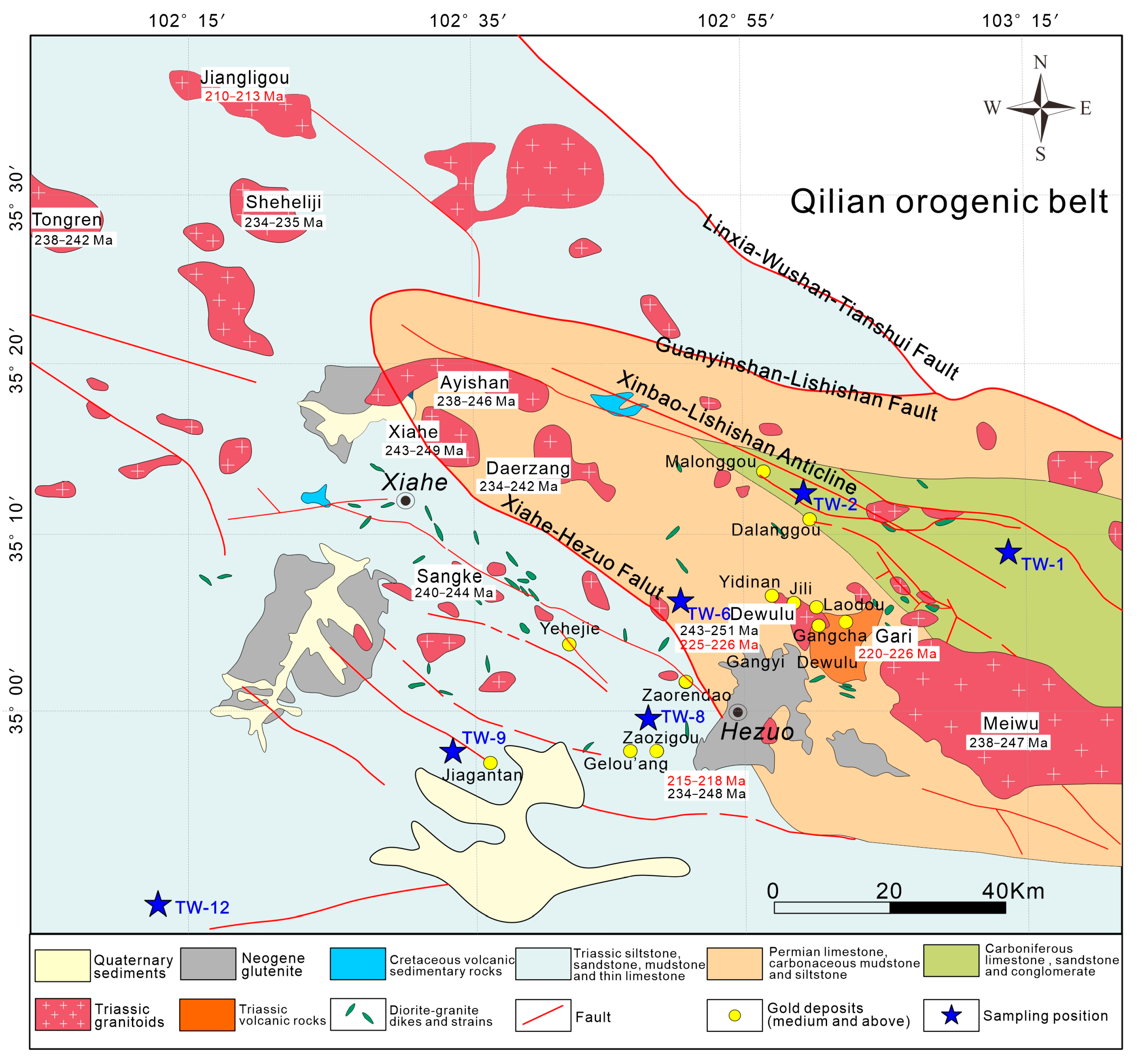
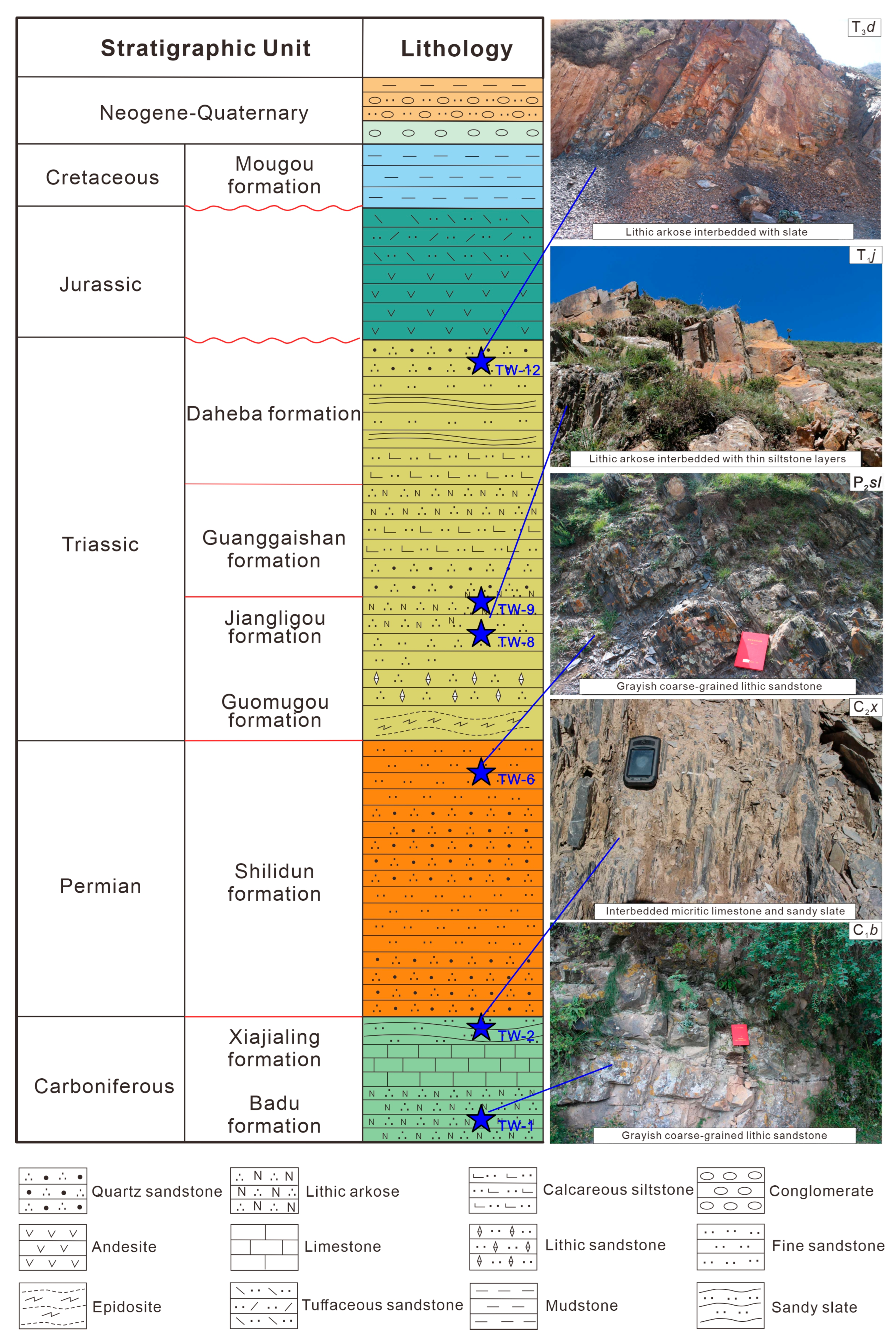
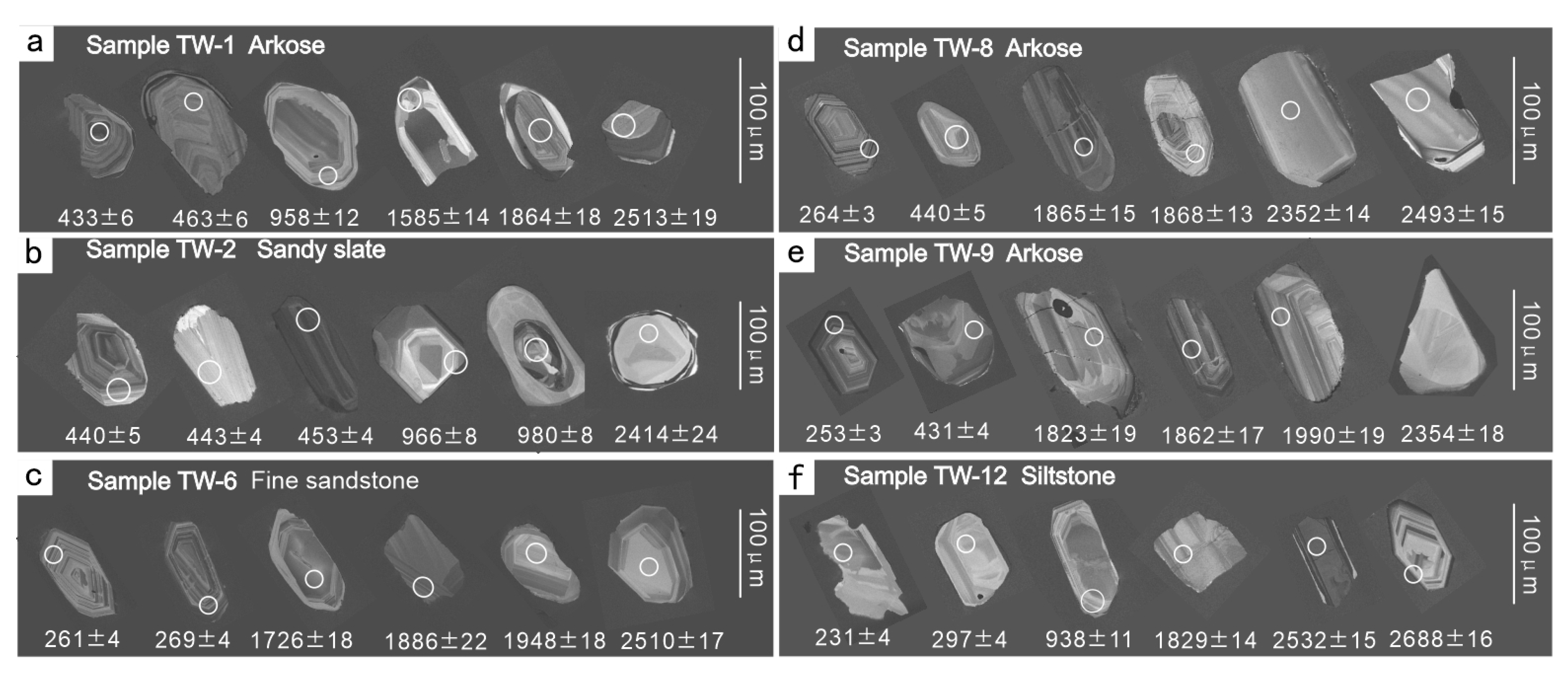
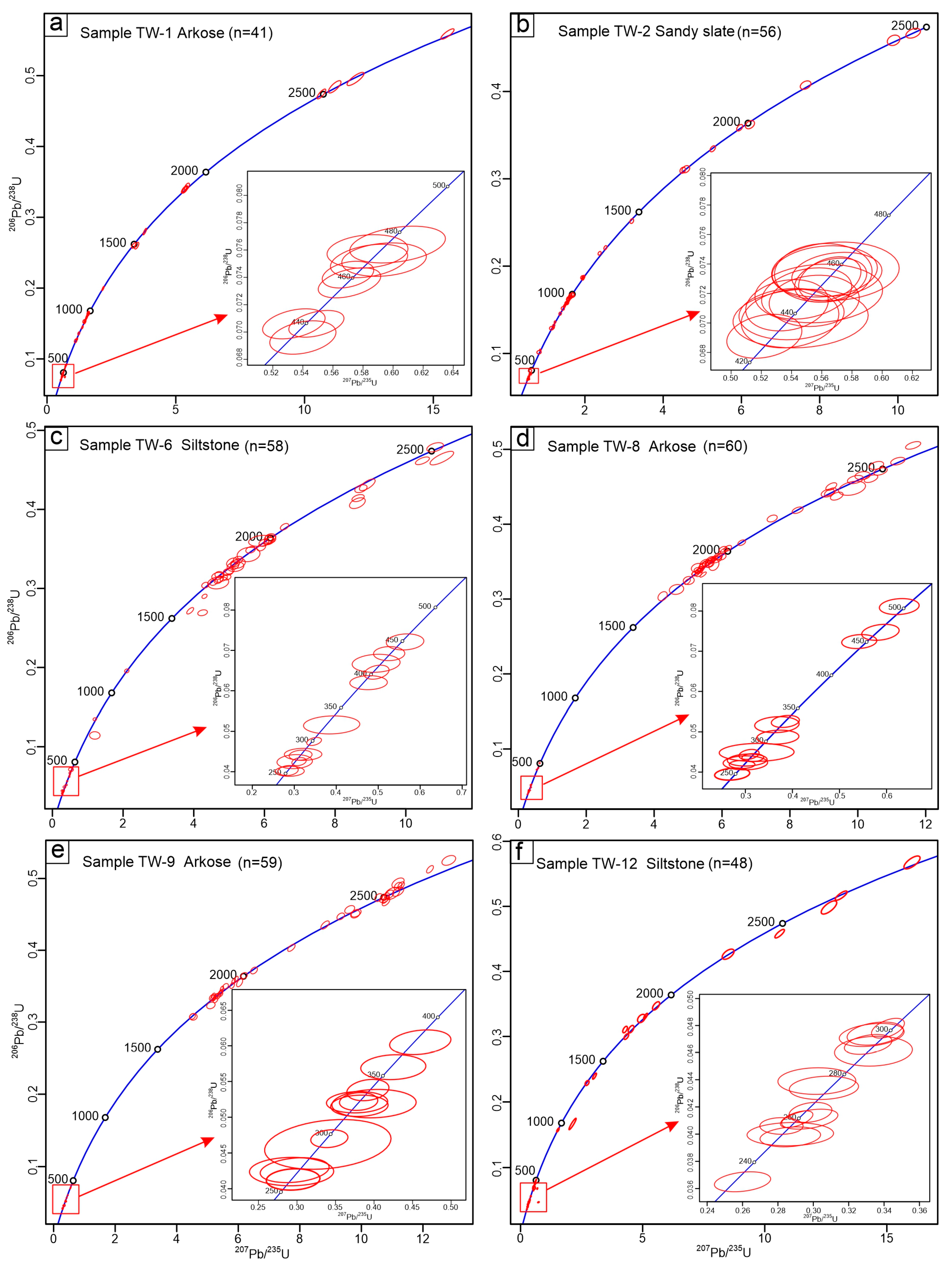
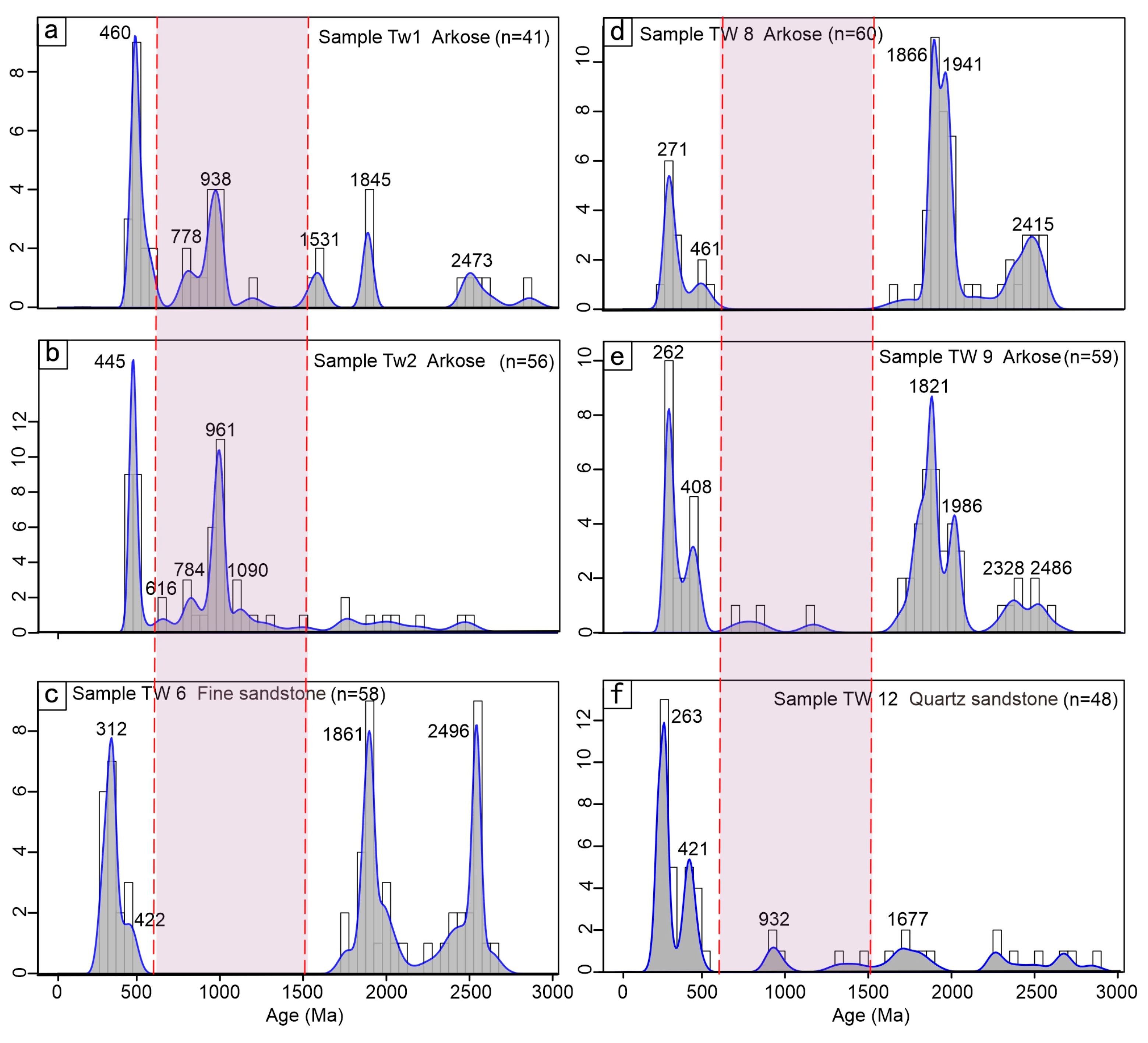
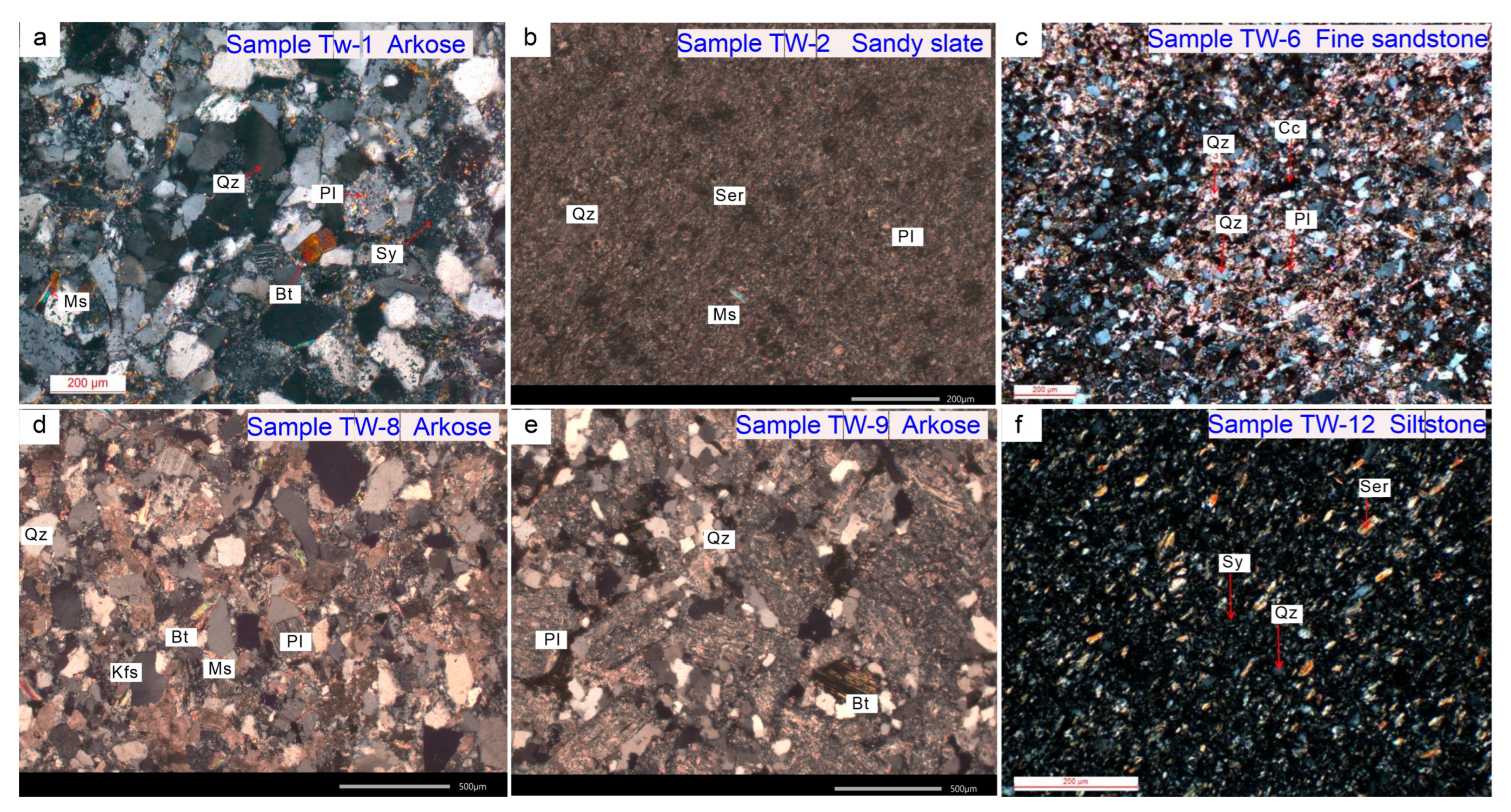
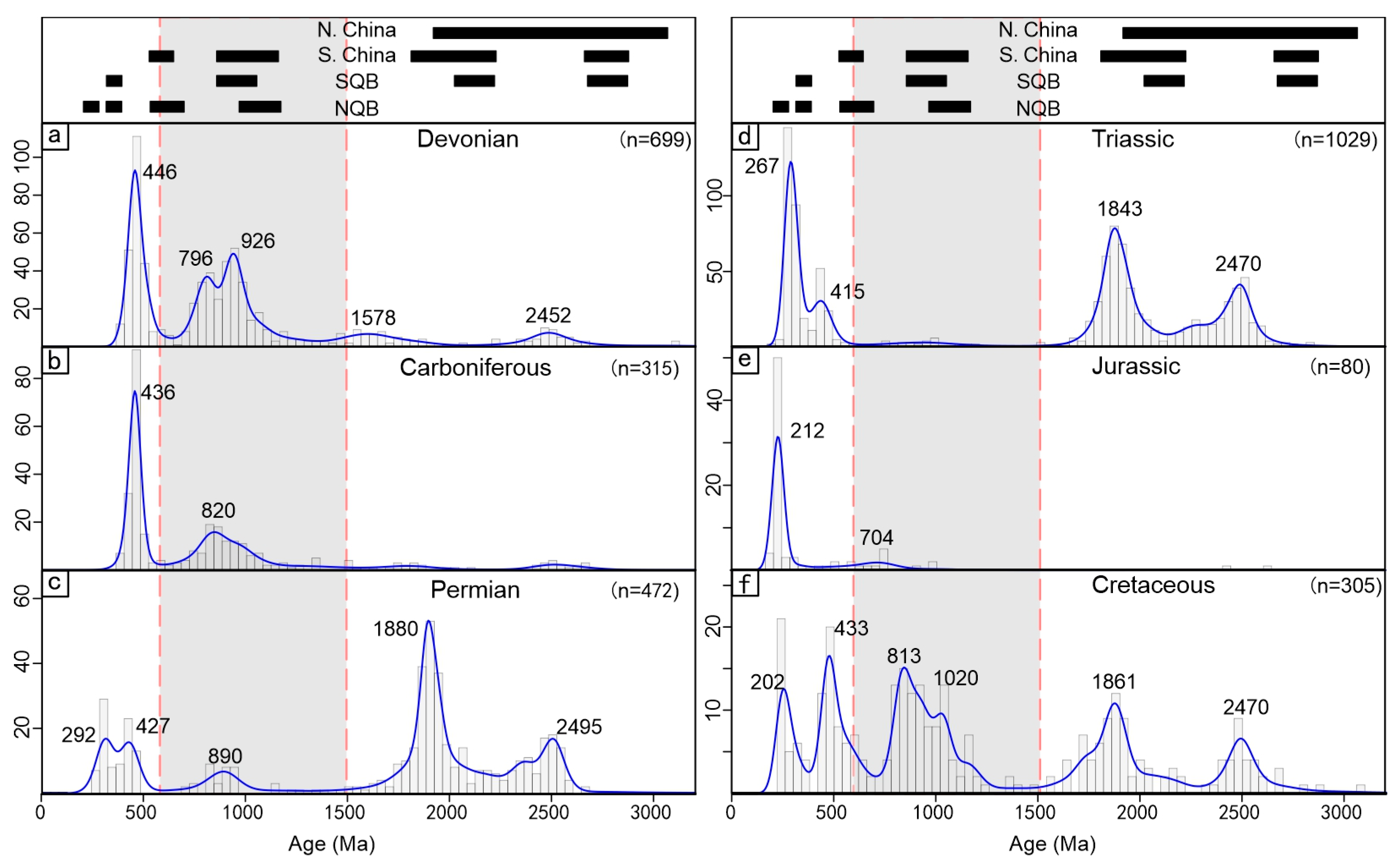
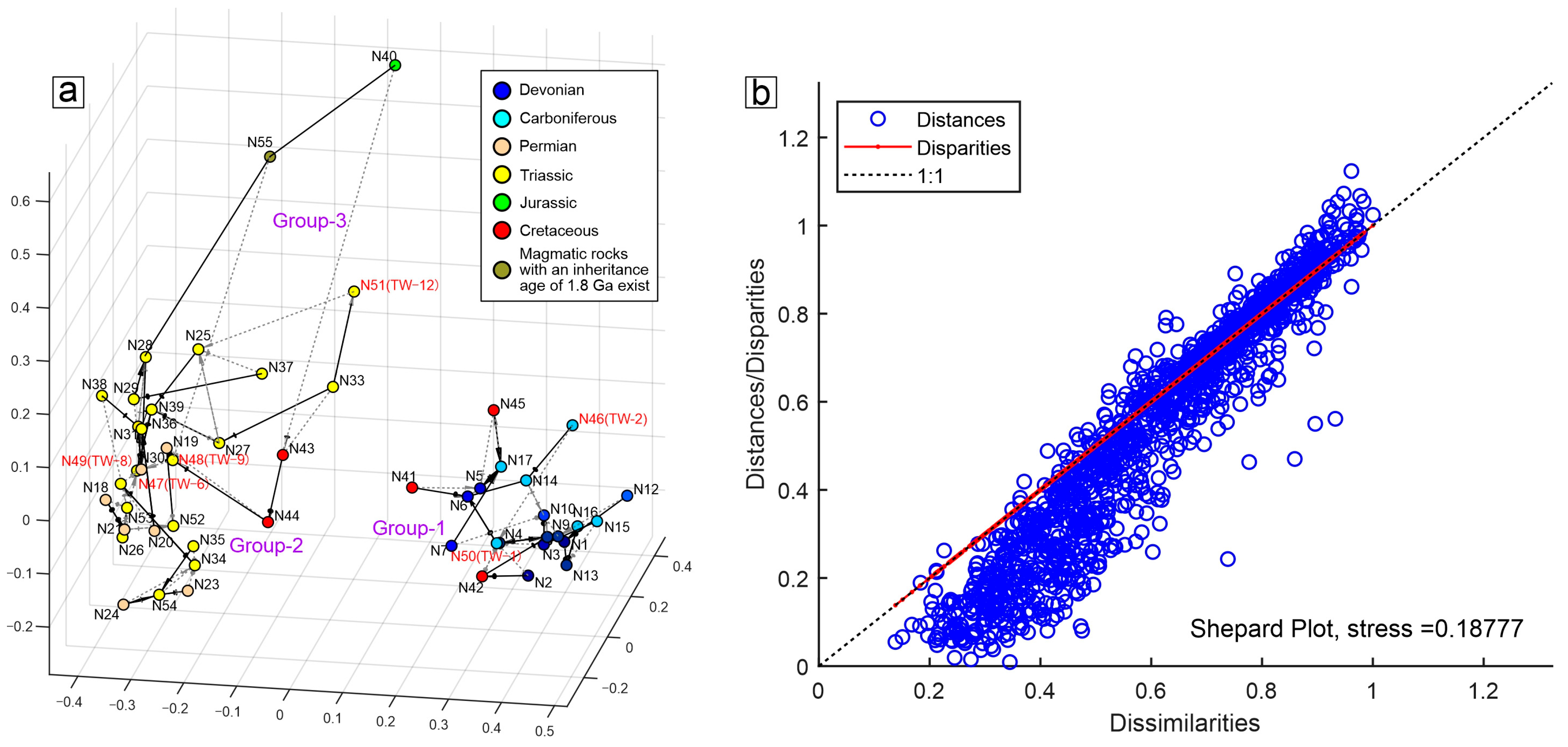
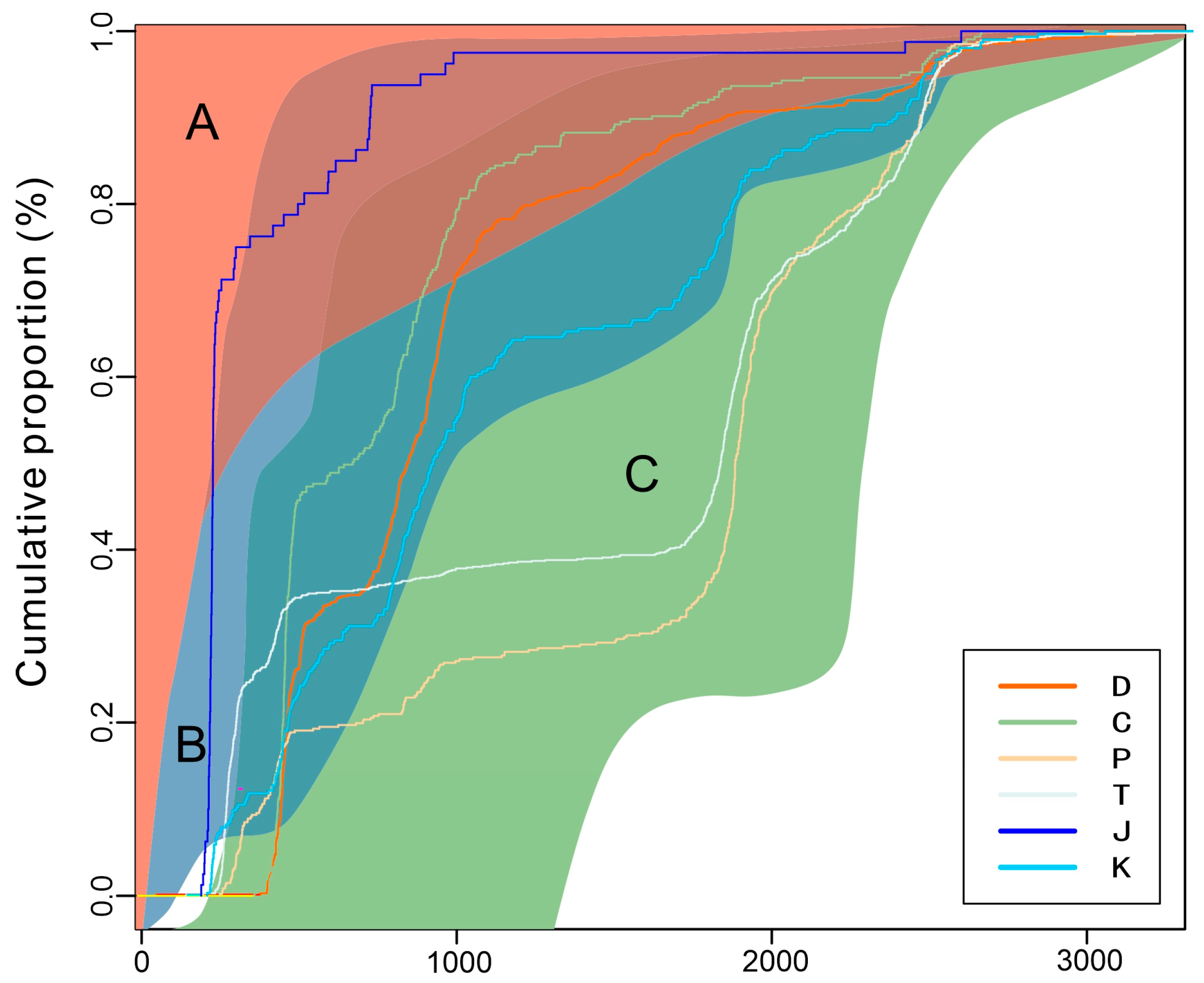
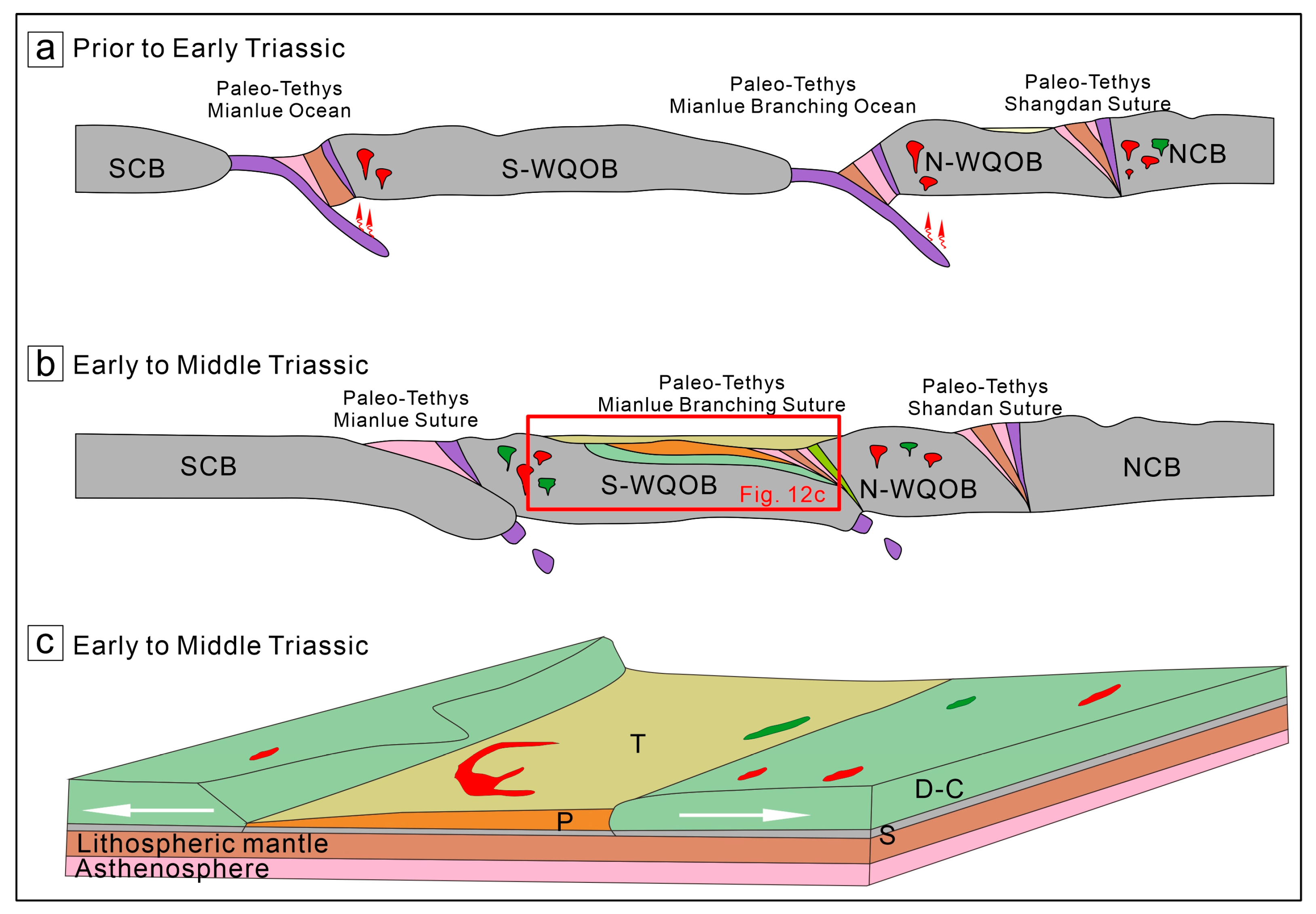
Disclaimer/Publisher’s Note: The statements, opinions and data contained in all publications are solely those of the individual author(s) and contributor(s) and not of MDPI and/or the editor(s). MDPI and/or the editor(s) disclaim responsibility for any injury to people or property resulting from any ideas, methods, instructions or products referred to in the content. |
© 2025 by the authors. Licensee MDPI, Basel, Switzerland. This article is an open access article distributed under the terms and conditions of the Creative Commons Attribution (CC BY) license (https://creativecommons.org/licenses/by/4.0/).
Share and Cite
Li, H.; Yan, K.; Li, K.; Yang, K.; Fan, B.; Xue, Z.; Chen, L.; Guo, H. Detrital Zircon U-Pb Age Data and Geochemistry of Clastic Rocks in the Xiahe–Hezuo Area: Implications for the Late Paleozoic–Mesozoic Tectonic Evolution of the West Qinling Orogen. Geosciences 2025, 15, 384. https://doi.org/10.3390/geosciences15100384
Li H, Yan K, Li K, Yang K, Fan B, Xue Z, Chen L, Guo H. Detrital Zircon U-Pb Age Data and Geochemistry of Clastic Rocks in the Xiahe–Hezuo Area: Implications for the Late Paleozoic–Mesozoic Tectonic Evolution of the West Qinling Orogen. Geosciences. 2025; 15(10):384. https://doi.org/10.3390/geosciences15100384
Chicago/Turabian StyleLi, Hang, Kang Yan, Kangning Li, Ke Yang, Baocheng Fan, Zhongkai Xue, Li Chen, and Haomin Guo. 2025. "Detrital Zircon U-Pb Age Data and Geochemistry of Clastic Rocks in the Xiahe–Hezuo Area: Implications for the Late Paleozoic–Mesozoic Tectonic Evolution of the West Qinling Orogen" Geosciences 15, no. 10: 384. https://doi.org/10.3390/geosciences15100384
APA StyleLi, H., Yan, K., Li, K., Yang, K., Fan, B., Xue, Z., Chen, L., & Guo, H. (2025). Detrital Zircon U-Pb Age Data and Geochemistry of Clastic Rocks in the Xiahe–Hezuo Area: Implications for the Late Paleozoic–Mesozoic Tectonic Evolution of the West Qinling Orogen. Geosciences, 15(10), 384. https://doi.org/10.3390/geosciences15100384




